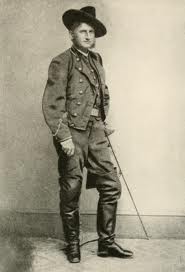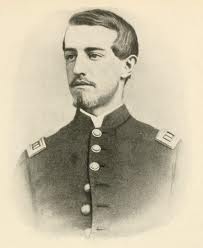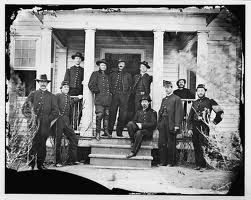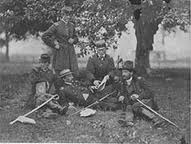 Kilpatrick’s Bravado or Dahlgren’s Sacrifice, is one of the Civil War’s many tales of mystery and political intrigue that has become the center of a debate between historians and academics, regarding an infamous raid on the Capitol of the Confederacy. The brainchild of the flamboyant Brigadier General H. Judson Kilpatrick, the cavalry raid turned into a fiasco when Kilpatrick’s men were stopped northwest of Richmond, Virginia and a supporting column, under the command of twenty-one-year-old Colonel Ulric Dahlgren, was routed to the east. Kilpatrick, whose nickname was Kill Cavalry, had a history of utter disregard for the lives of his troopers, but whose rashness and daring had gained him the respect and admiration of President Abraham Lincoln, who whole heartedly endorsed the raid.
Kilpatrick’s Bravado or Dahlgren’s Sacrifice, is one of the Civil War’s many tales of mystery and political intrigue that has become the center of a debate between historians and academics, regarding an infamous raid on the Capitol of the Confederacy. The brainchild of the flamboyant Brigadier General H. Judson Kilpatrick, the cavalry raid turned into a fiasco when Kilpatrick’s men were stopped northwest of Richmond, Virginia and a supporting column, under the command of twenty-one-year-old Colonel Ulric Dahlgren, was routed to the east. Kilpatrick, whose nickname was Kill Cavalry, had a history of utter disregard for the lives of his troopers, but whose rashness and daring had gained him the respect and admiration of President Abraham Lincoln, who whole heartedly endorsed the raid.
At the heart of the scheme, Kilpatrick planned to free more than 1,500 Union officers held prisoner in Richmond, plus an additional 10,000 Union enlisted men crammed into the prison camp on Belle Isle in the James River. In addition, Lincoln had wanted to spread the word of his Proclamation of Amnesty and Reconstruction, in hopes of convincing the Confederates to lay down their arms and the Kilpatrick raid seemed to be an appropriate opportunity. There were only three stated objectives for the raid: free the prisoners in Richmond’s military prisons, destroy Rebel communications, and distribute the president’s amnesty proclamation behind Confederate lines. After Lincoln’s meeting with Kilpatrick, the President sent him to confer with Secretary of War Stanton, there is good reason to believe that Kilpatrick’s planning meeting in Stanton’s office was pivotal, because the sole surviving account of the meeting is Kilpatrick’s, dated February 16, and consists of his plan for the raid as submitted, at Stanton’s request and included, as it proved, to carry out certain highly secret tasks as well.
 In late February 1864, Dahlgren, who had lost his right leg in a skirmish after the Battle of Gettysburg, was recruited for a job with Kilpatrick. He was the youngest Union colonel and the son of Rear Adm. John Dahlgren, a friend of President Lincoln, Ulric was made second in command to Kilpatrick and was slated to head one of two flying columns of cavalry. Dahlgren was charged with penetrating Richmond, releasing Union prisoners and creating chaos in the city. On the eve of the raid, and fully briefed on the secret role he was to play, Dahlgren wrote his father a letter that stated, “there is a grand raid to be made, and I am to have a very important command. If successful, it will be the grandest thing on record; and if it fails, many of us will ‘go up‘…but it is an undertaking that if I were not in, I should be ashamed to show my face again.”
In late February 1864, Dahlgren, who had lost his right leg in a skirmish after the Battle of Gettysburg, was recruited for a job with Kilpatrick. He was the youngest Union colonel and the son of Rear Adm. John Dahlgren, a friend of President Lincoln, Ulric was made second in command to Kilpatrick and was slated to head one of two flying columns of cavalry. Dahlgren was charged with penetrating Richmond, releasing Union prisoners and creating chaos in the city. On the eve of the raid, and fully briefed on the secret role he was to play, Dahlgren wrote his father a letter that stated, “there is a grand raid to be made, and I am to have a very important command. If successful, it will be the grandest thing on record; and if it fails, many of us will ‘go up‘…but it is an undertaking that if I were not in, I should be ashamed to show my face again.”
The operation, February 28–March 3, 1864, had three parts. Kilpatrick had the main body, 3,500 men, of which 500 under Dahlgren would split off and circle to the west and hit the Richmond defenses in the flank. Meanwhile, the Army of the Potomac would demonstrate to draw the Rebels attention, another cavalry raid by 1,500 men under George Armstrong Custer, would ride much further to the west. Custer’s operation was a complete success. He threatened Charlottesville, captured about 50 prisoners and 500 horses and returned 3 days later, with few wounded.
Early on February 28, under the cover of an infantry and cavalry diversion that Meade launched westward around Lee’s left flank, Kilpatrick and Dahlgren led some 3500 troopers across the Rapidan River and past Lee’s right to begin their ride south toward Richmond. The next day Dahlgren split off, taking 500 men wide to the west, aiming to
cross the James River 25 miles above Richmond and push on to the city’s lightly defended southern flanks. Kilpatrick was to strike at the northern fortfications, while Dahlgren saw to the prisoners release.
Nothing went according to plan. Dahlgren discovered the James was running too high to cross. In a fit of anger, he turned on his guide, a black freedman supplied and vouched for by the Bureau of Military Intelligence, John Babcock, and had the man hanged from a tree. Proceeding toward Richmond, but on the northern side of the James, Dahlgren soon ran into the city’s militia defenders and gave up on his mission, turning away to the north to rejoin Kilpatrick.
 In the meantime, Kill Cavalry, had reached Richmond’s outer defenses, where he found no trace of Dahlgren’s force. Kilpatrick became discouraged and after some minor skirmishing, withdrew to consider his next his next move and was assaulted from the rear by Rebel cavalry. General Kilpatrick then reported, “I have abandoned all further ideas of releasing our prisoners.” Leaving Dahlgren and his men to their fate, Kill-Cavalry rushed down the Peninsula to the safety of General Butler’s lines.
In the meantime, Kill Cavalry, had reached Richmond’s outer defenses, where he found no trace of Dahlgren’s force. Kilpatrick became discouraged and after some minor skirmishing, withdrew to consider his next his next move and was assaulted from the rear by Rebel cavalry. General Kilpatrick then reported, “I have abandoned all further ideas of releasing our prisoners.” Leaving Dahlgren and his men to their fate, Kill-Cavalry rushed down the Peninsula to the safety of General Butler’s lines.
Most of Dahlgren’s men would finally reach the Union lines, but in a freezing
rain, the colonel and about 100 men were separated from the rest. On the night of March 2, the Confederates ambushed them and the first Confederate volley killed the young
colonel.
Shortly after the ambush in which Dahlgren was killed, thirteen-year-old William Littlepage, a young soldier of the home militia, came upon the colonel’s body and searched it. What he found came to be called the Dahlgren Papers, two folded documents and a pocket notebook containing several loose papers inserted between the leaves. The young boy showed his commander, Captain Edward Halbach, what he had found. At daylight on March 3, Halbach looked over the papers and was shocked at what Dahlgren wrote, “We hope to release the prisoners from Belle Island first & having seen them fairly started we will cross the James River into Richmond, destroying the bridges after us & exhorting the released prisoners to destroy and burn the hateful City & do not allow the Rebel Leader Davis and his traitorous crew to escape.” An address to his troops on Cavalry Corps stationery was even more explicit, “The City it must be destroyed and Jeff. Davis and Cabinet killed.”
It was close to noon on March 4 when Lieutenant Pollard reached Richmond and delivered Dahlgren’s papers and his wooden leg to cavalry Major General Fitzhugh Lee, nephew of the Army of Northern Virginia’s commander. Having led the ambush of the Dahlgren party, Pollard gave General Lee a full briefing on the finding of the papers and their identification. “Upon ascertaining their contents,” Lee recalled, “I immediately took them to Mr. Davis.” In the president’s office he found Davis in consultation with Secretary of State Judah Benjamin. Davis listened to Lee’s briefing and then read aloud from the two documents, the address, and the set of instructions. He made no comment until he reached the instruction “once in the City it must be destroyed & Jeff. Davis and Cabinet killed.” At that, he remarked with a laugh, “That means you, Mr. Benjamin.” Apparently dismissing the matter from his mind, the president told Lee to deliver the papers to the War Department. The decision was made, apparently by Secretary of War James A. Seddon, to call in the newspapers and go public with this stark evidence of Northern brutality.
Richmond newspapers screamed the news of the North’s barbarity, “The Last Raid of the Infernals!” Some demanded a summary trial and execution of the captured raiders, but General Robert E. Lee counseled against it. Instead, he ordered a set of photographs of the papers made and sent to Major General George Meade, the Union commander. The papers, Meade told his wife, seemed a “pretty ugly piece of business.” He ordered Kilpatrick to find out whether Dahlgren had issued the orders to his men. Kill Cavalry said he had read Dahlgren’s proposed address to his men and marked it in red ink as “approved.” It read just as the newspapers had printed it, except it was missing his endorsement and the sentence exhorting the prisoners to burn Richmond and kill the Confederate leaders. “All this is false,” declared Kilpatrick, who said the rebels must have forged the documents.
Meade’s reply to Lee stated that “neither the United States Government, myself, nor General Kilpatrick authorized, sanctioned, or approved the burning of the city of Richmond and the killing of Mr. Davis and cabinet” and enclosed a somewhat toned-down version of Kilpatrick’s denial that only hinted that the papers had been forged. No one had ordered or authorized Colonel Dahlgren to commit any criminal acts, the awful tale began and ended with him. In his diary for March 12, Union Provost Marshal Brigadier General Marsena Patrick recorded a conversation with a military intelligence officer who rode on the raid,”He has the same opinion of Kilpatrick that I have and says he managed just as all cowards do, He thinks the papers are correct that were found upon Dahlgren, as they correspond with what D. told him.” Northern newspapers and Dahlgren’s grieving father declared the papers to be “a bare-faced atrocious forgery.”
Two days after the Dahlgren papers were released to the press, an editor of the Richmond Sentinel expressed an opinion on the question of guilt that was widely applauded across the South. “Dahlgren’s infamy did not begin or die with him,” the editor wrote, “he was but the willing instrument for executing an atrocity which his superiors had carefully approved and sanctioned. Truly there is no depth of dishonor and villainy to which Lincoln and his agents are not capable of descending.”
The Dahlgren Papers served as reason enough for the Confederate leaders to finally approve plans to whip up armed rebellion among Southern sympathizers in the North. They also encouraged a plot to bomb the White House and kill President Lincoln. The actor John Wilkes Booth was believed to have been part of that plot. When it failed, it is conjectured, Booth decided to take more direct action.
 In November 1865, seven months after Lee surrendered at Appomattox, Lincoln’s Secretary of War, Edwin Stanton, ordered Francis Lieber, the keeper of captured Confederate records, to turn over everything relating to the raid. Lieber gave Stanton the original papers and notebook found on Dahlgren’s body, plus all relevant correspondence from the Confederate archives, none of the original Dahlgren Papers were ever seen again.
In November 1865, seven months after Lee surrendered at Appomattox, Lincoln’s Secretary of War, Edwin Stanton, ordered Francis Lieber, the keeper of captured Confederate records, to turn over everything relating to the raid. Lieber gave Stanton the original papers and notebook found on Dahlgren’s body, plus all relevant correspondence from the Confederate archives, none of the original Dahlgren Papers were ever seen again.
Whether Kilpatrick’s Bravado was just an indication of his own insecurity or blatant cowardice, one thing is for sure, Dahlgren’s ultimate Sacrifice went unrewarded and the young, naive, Cavalry Colonel will always be remembered as the author of the infamous Dahlgren Papers.
Bummer
Thanks to Mr. John Roark for suggesting this post!

